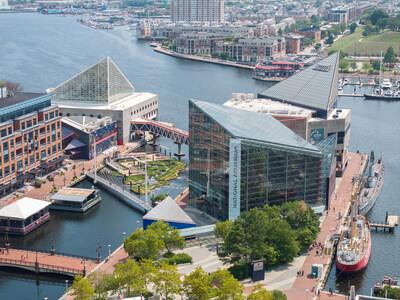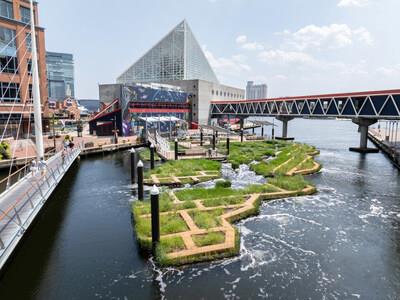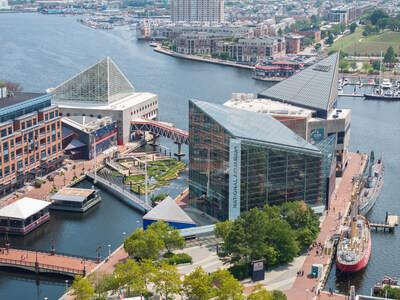
National Aquarium Unveils Harbor Wetland Exhibit, Recalling Chesapeake Bay Habitat To Inner Harbor
BALTIMORE, Aug. 8, 2024 /PRNewswire/ -- The National Aquarium is now welcoming guests to
Harbor Wetland , a 10,000-square-foot floating wetland that mimics the Inner Harbor's original Chesapeake Bay tidal marsh habitat, beckoning native marine species back to Baltimore. The wetland, situated between Piers 3 and 4 on Baltimore's Inner Harbor, features more than 32,000 native shrubs and marsh grasses and is based upon sustainable innovations developed by the Aquarium's conservation and exhibit fabrication teams. Beginning today, Harbor Wetland will welcome Inner Harbor visitors as a free and accessible experience available at no cost and without an Aquarium ticket during the Aquarium's normal operating hours, barring extreme weather or other outdoor conditions. The $14 million project is presented by Baltimore's own CFG Bank, with other notable private investment from The Whiting-Turner Contracting Company, The Bunting Family Philanthropies and Constellation, as well as the Aquarium's philanthropic community, and local, state, and federal government support.
Harbor Wetland is a functional constructed wetland, a floating classroom and an engaging public attraction.
Post this
After months of construction, the Harbor Wetland exhibit is complete. | August 1, 2024

After months of construction, the Harbor Wetland exhibit is complete. | August 1, 2024
"Harbor Wetland
is the culmination of 12 years of research, innovation and determination," said Aquarium President and CEO John Racanelli. "We're so excited to welcome Baltimore residents and visitors out onto the water for a close-up view of the vibrant, living habitat taking root here in the Inner Harbor."
Harbor Wetland
is a functional constructed wetland, a floating classroom and an engaging public attraction, outfitted with docks and walkways, shade cover and interpretive signage that allows guests to learn about the wetland and the species drawn to it while highlighting seasonal changes and the sights and sounds of the bustling harbor around it. The habitat is made up of recycled plastic matting planted with tidal wetland shrubs and grasses native to this region whose roots will grow down into the water, providing microhabitats for dozens of native species and drawing nutrients and contaminants from the water. The matting is coated with a UV protectant for durability and fixed to a system of air-regulated pontoons that allow for adjustable buoyancy of the wetland to offset weight gain from growing biomass.
Water circulates through the wetland's shallow channel by compressed air pumped into the channel using strategically placed airlifts. Compressed air is supplied to ceramic airstones positioned at the bottom of custom-designed six-foot-long airlift pipes. Thousands of tiny bubbles produced by the airstones rise to the surface, moving water through the wetland's shallow channel. Bubbles also release oxygen into the surrounding water, benefiting aquatic species by raising dissolved oxygen levels and keeping water moving throughout the wetland as it would during tidal changes in a natural tidal marsh.
"Natural habitat restoration is a key part of our all-hands-on-deck strategy to improve the health of the Chesapeake Bay. That's why I've fought to support the National Aquarium's efforts to create this floating wetland right in the heart of downtown Baltimore. Not only will this innovative approach bring Bay wildlife back to the Inner Harbor; it will also serve as a living educational resource, helping strengthen the culture of shared responsibility for protecting our treasured Bay for generations to come," said Senator Van Hollen, who worked to secure $564,700 to support this project through Congressionally Directed Spending and the
Chesapeake WILD program he authored.
Under the direction of General Curator Jack Cover, a 37-year veteran of the National Aquarium whose knowledge of Chesapeake Bay ecology comes from countless hours spent exploring tidal marshes; Director of Field Conservation Charmaine Dahlenburg, who oversees the Aquarium's hands-on conservation projects throughout the Chesapeake Bay region; and Director of Exhibit Fabrication & Operations Paul Valiquette, who manages the Aquarium's award-winning exhibit fabrication team, application for three scientific patents has been submitted to the U.S. Patent Office. The patents sought relate to the buoyancy and aeration systems that make this floating wetland project different from previous prototypes developed at the National Aquarium and elsewhere. Patents are pending. The wetland system that now serves as the foundation for Harbor Wetland is an expansion of the ultimate successful wetland design that has been in the water between Piers 3 & 4 of the Aquarium's campus for seven years.
To Jack Cover, the project is transformational not only for the Aquarium and the Inner Harbor, but also for perceptions of the Inner Harbor. "We hear so much negative talk about Inner Harbor water quality, but there is life in this water and there always has been," he said. "My hope is that when people see the life this wetland attracts, from tiny microorganisms to fishes, crabs, water birds and even small mammals like muskrats and otters-all of which we're already seeing here-they might reconsider our local waterways and perhaps even take better care of our natural surroundings."
"The National Aquarium is one of my – and my family's – favorite places, and our team at CFG has actively volunteered to help plant
Harbor Wetland, so I couldn't be more excited for its opening," said CFG Bank CEO Jack Dwyer. "I've always been passionate about giving back to organizations rooted in education and recreation, and over the years, CFG has been proud to support the National Aquarium to further its mission. The opening of
Harbor Wetland
is an incredible milestone."
Throughout the process of imagining, reimagining and eventually realizing the vision for Harbor Wetland, the Aquarium's team has partnered with Baltimore-based architects Ayers Saint Gross, who, as architects of record on the project, integrated the science developed at the Aquarium into their design of the project's "dry" and wetland functionality. In the construction and build-out of that final design, Baltimore's Whiting-Turner has served as the contractor, working within plans, conditions and materials unique to this first-of-its-kind structure. At the project's inception in 2014, Chicago-based Studio Gang participated as the original concept architects.
According to Aquarium Vice President of Planning & Design Jacqueline Bershad, these partnerships were critical and transformative. "When undertaking something that has not been done before on this scale, it is so important to have partners who not only see but also believe in your vision," said Bershad. "We have benefitted beyond measure from the expertise, flexibility and cooperation of our partners."
In its role as a hands-on classroom for the Aquarium's conservation education programming, Harbor Wetland will welcome students from throughout the region, including those enrolled in What Lives in the Harbor, a free science curriculum available to all Baltimore City Public Schools sixth graders that has previously culminated in a field trip utilizing the Aquarium's outdoor pier spaces. Visiting students will now be able to get closer than ever to their most local waterway on Harbor Wetland, an experience complemented by the completion of a stunning mural by Baltimore artist Nether
on the Aquarium's Pier 4 west-facing wall, and soundscapes piped through the exhibit's sound system.
National Aquarium
The National Aquarium is a nonprofit organization whose mission is to connect people with nature to inspire compassion and care for our ocean planet.
Our compelling exhibits, science-based education programs and hands-on field initiatives engage more than 1.2 million people annually. One of the top three aquariums in the United States and the largest paid cultural attraction in Maryland, the Aquarium generates more than $430 million annually in economic impact to the state. For
more information on the National Aquarium, visit
.
Media Contact:
PROFILES PR
(410) 243-3790
[email protected]
SOURCE National Aquarium

Legal Disclaimer:
MENAFN provides the
information “as is” without warranty of any kind. We do not accept
any responsibility or liability for the accuracy, content, images,
videos, licenses, completeness, legality, or reliability of the information
contained in this article. If you have any complaints or copyright
issues related to this article, kindly contact the provider above.


















Comments
No comment